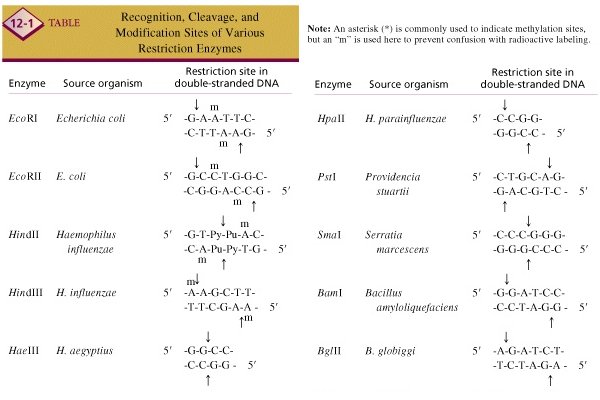
Some examples of Type II restriction endonucleases
Restriction endonucleases
are used by bacteria to recognize foreign DNA and destroy
(restrict) it by introducing double-stranded cuts at
characteristic recognition
sites. They are named after the bacterial species
from which they were first isolated. For example, EcoRI was the (I)st (R)estriction endonuclease isolated
from E. coli: Eco
+ R + I. Most endonucleases used in
molecular biology recognize four
or six base sites (tetraschizomers or hexaschizomers,
"four-cutters" or "six-cutters"). Some have
10 bp sites, and are called "long
cutters" because the interval between sites is much
greater.
Restriction sites are molecular palindromes. A palindrome is a word or phrase that reads the same forward or backward: "Able was I ere I saw Elba", "Madame I'm Adam", "Doc: note, I dissent. A fast never prevents a fatness. I diet on cod". (The one-word record holder is the Finnish word for a soap seller, "Saippuakauppias"). DNA palindromes read the same forward and backward in the double-stranded molecule. In the first example above, the recognition site of EcoRI is 5'-GAATTC-3', so the paired strand is 3'-CTTAAG-5': the double-stranded 6 bp sequence therefore reads the same in either 5'-3' direction. The cut occurs at 5'-G/A on either strand, leaving both with a single-stranded 5'-AATT tail.
Restriction sites are molecular palindromes. A palindrome is a word or phrase that reads the same forward or backward: "Able was I ere I saw Elba", "Madame I'm Adam", "Doc: note, I dissent. A fast never prevents a fatness. I diet on cod". (The one-word record holder is the Finnish word for a soap seller, "Saippuakauppias"). DNA palindromes read the same forward and backward in the double-stranded molecule. In the first example above, the recognition site of EcoRI is 5'-GAATTC-3', so the paired strand is 3'-CTTAAG-5': the double-stranded 6 bp sequence therefore reads the same in either 5'-3' direction. The cut occurs at 5'-G/A on either strand, leaving both with a single-stranded 5'-AATT tail.
Figure © 2000 by Griffiths et al. ; text © 2025 by Steven M. Carr